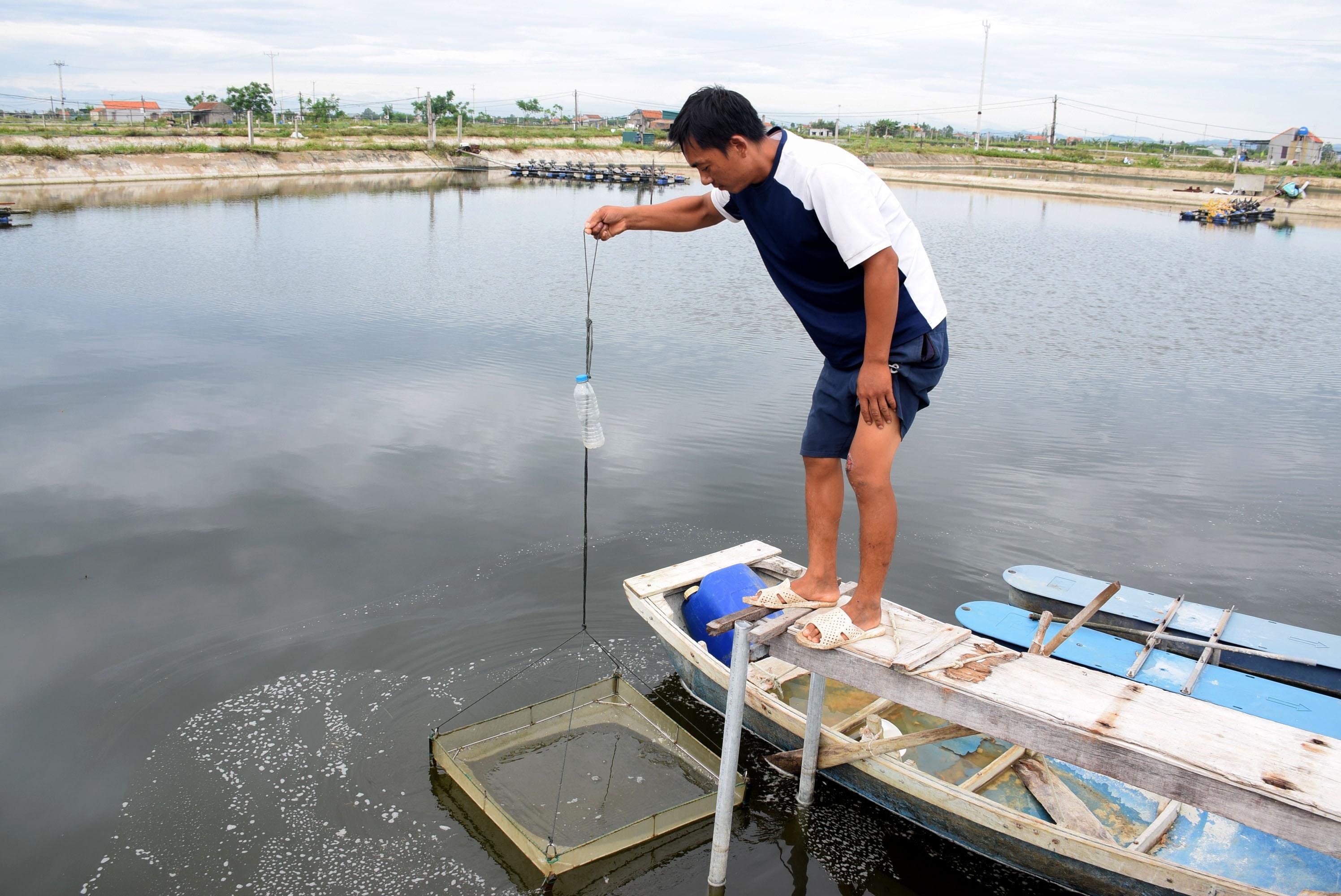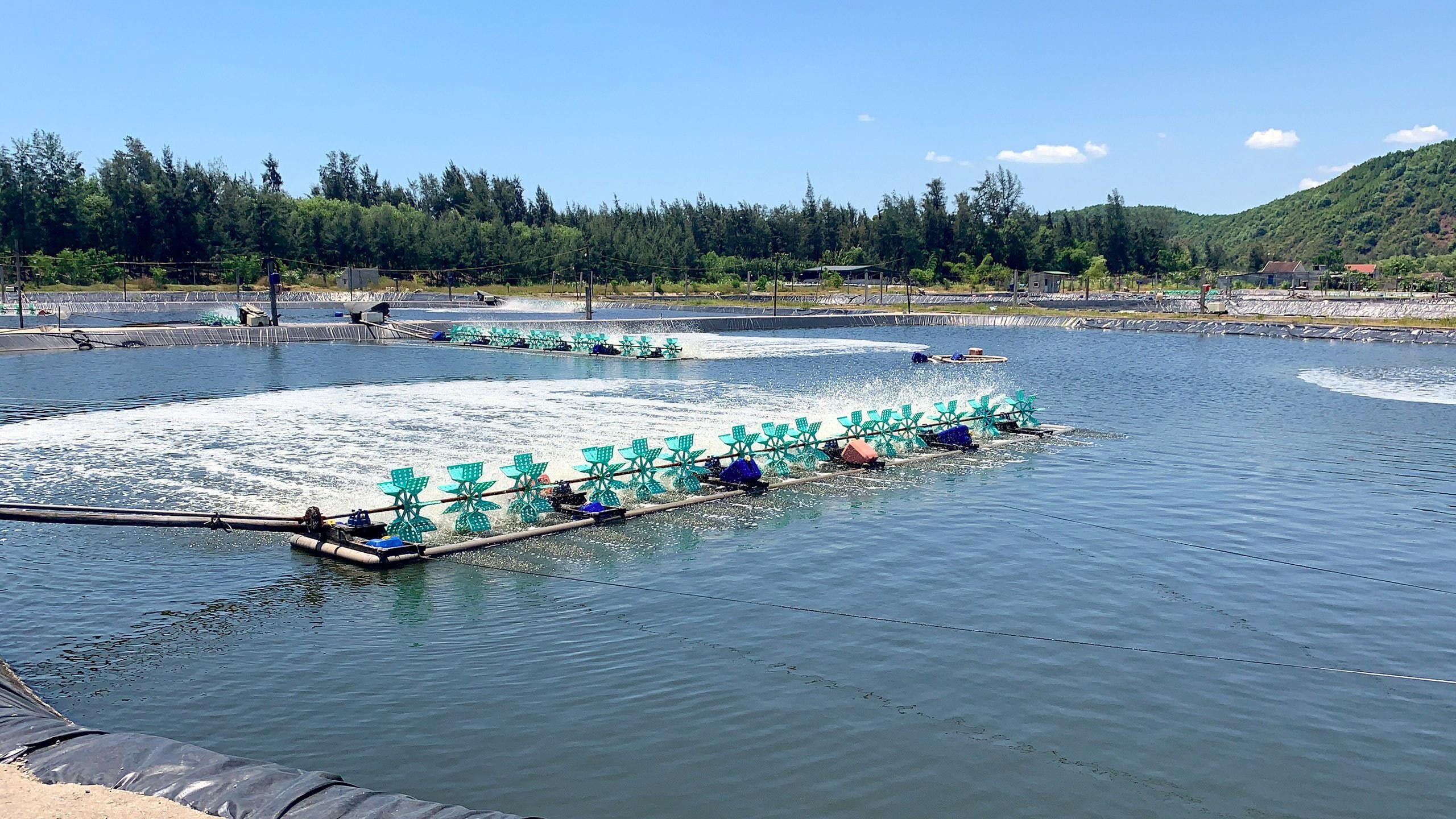Application of technology and digital transformation in shrimp farming
(Baonghean.vn) - Nghe An has the potential to develop brackish water shrimp farming, with an annual farming area of over 2,200 hectares, and a shrimp output of over 12,000 tons. However, shrimp farming areas in the province have faced many risks in recent years, with many shrimp farmers suffering losses. One solution to bring efficiency to the shrimp farming industry is to apply high technology and digital transformation to the farming process.
Risks and disadvantages
Shrimp farming in particular, and the aquaculture industry in general in Nghe An have affirmed their potential and advantages. For a long time, shrimp farmers in the province have invested in intensive farming, applying scientific and technical advances, bringing higher economic efficiency. However, shrimp farming is facing many challenges such as the ability to control diseases, monitor the health of farmed shrimp and trace the origin after being sold to the market.
 |
| Shrimp farmers in Quynh Luu district are suffering losses due to frequent disease outbreaks. Photo: Xuan Hoang. |
Mr. Ho Mau Thanh - owner of a shrimp pond in Hamlet 2, Quynh Luong Commune (Quynh Luu) said that although his family invested in shrimp farming according to VietGAP standards, all input steps were done manually, and daily bookkeeping was often careless, so shrimp farming was not strictly and accurately controlled. Therefore, farmed shrimp were often infected with diseases and grew slowly.
If new techniques are applied and digital transformation is implemented in commercial shrimp farming, with little damage, successful farming and profit, people will boldly follow suit. We hope to receive support in investing in applying new technologies as well as technical training so that farmers can feel secure in shrimp farming.
Is a locality with an area ofbrackish water shrimp farmingConcentrated on 50 hectares, Quynh Luong commune considers shrimp farming as one of the economic spearheads, however in recent years, shrimp farming is often infected with diseases, so the efficiency is not high.
Mr. Nguyen Van Tue - Chairman of Quynh Luong Commune People's Committee also said that although some areas have applied VietGAP farming process, it is still mainly manual method, so the monitoring of all daily shrimp farming stages is not accurate. Therefore, if technology is applied and systematically transferred from input to output, it will bring higher economic efficiency, helping shrimp farmers feel more secure in disease control and other stages. However, in order for shrimp farmers in the commune to widely apply technology and digital transformation in shrimp farming, there needs to be specific models, because most people do not understand this technology.
According to the assessment of the Department of Fisheries, in recent years, shrimp farmers in the province have gradually applied new science and technology: biotechnology, multi-stage farming, circulating farming... combined with investment in upgrading infrastructure in both farming areas and each farming facility (building greenhouse systems, floating cages with roofs to stabilize temperature, limit the spread of pathogens and other impacts affecting shrimp growth,...) have increased productivity and product quality.
 |
Shrimp farming on sand in Dien Trung commune, Dien Chau district. Photo: Thu Huyen |
However, the area of multi-stage farming is not much, but most of the shrimp farming area in the province is raised in outdoor ponds according to the 1-stage process. With this form of farming, the initial investment in infrastructure, equipment, electricity and water systems to serve production in this form is not large. Therefore, it meets the majority of current farming facilities, requires lower initial costs than the multi-stage farming model, the floating tank/cage farming model and is suitable for households with limited economic potential. However, the disadvantages are that management is difficult, susceptible to disease, and there is a risk of natural disasters such as heat waves, storms and floods, leading to low efficiency and basically only raising one main crop per year.
Digital transformation is inevitable
Mr. Ta Quang Sang - Director of the Provincial Agricultural Extension Center said that, in the whole country, many places have applied high technology and digital transformation in shrimp farming, bringing high efficiency. Meanwhile, the shrimp farming area in Nghe An only has a number of demonstration models based on the general development orientation of the industry towards increasing the content of new scientific and technological advances, VietGAP, applying information technology in production... but has not applied digital transformation technology.
 |
| Nghe An's shrimp farming industry currently has many shortcomings and risks, so applying technology and digital transformation is a necessary solution. Photo: Xuan Hoang |
So,apply technology and digital transformation applicationsis a necessary and suitable solution in aquaculture, especially when shrimp farming is under a lot of pressure from climate change, environment, polluted water sources... like today. Applying technology helps manage farming more effectively from water sources, food, diseases, and facilitates traceability...
“To transform digitally in shrimp farming, farmers need to immediately change the production management method, replacing traditional pond monitoring and management with digital production management software. From there, farmers can easily manage feed, chemicals as well as the farming process, all stored on software applications via computers or phones. Therefore, converting to digital technology applications in aquaculture is necessary in the near future,” Mr. Ta Quang Sang emphasized.
 |
Applying floating tank shrimp farming technology in Dien Chau. Photo: Mai Giang |
With the great potential of the province's shrimp farming industry, Nghe An aims to develop shrimp farming into a large commodity production industry that creates key agricultural products in a sustainable manner.adapt to climate changeand protect the ecological environment; improve productivity, quality, value, production efficiency and competitiveness of Nghe An shrimp products; bring many benefits to related individuals/organizations, in order to ensure social security... Thereby contributing to the successful implementation of the Project on restructuring the agricultural sector towards increasing added value, sustainable development and the National Action Plan for developing the Vietnamese shrimp industry by 2025. Accordingly, by 2025, the annual shrimp farming area of Nghe An will reach 2,200 hectares, with shrimp farming output of 12,500 tons/year.
Recently, the Department of Agricultureand Rural DevelopmentIn coordination with the National Agricultural Extension Center, a seminar was held to develop digital transformation application models in aquaculture, with the participation of nearly 100 farmers representing a number of cooperatives, cooperative groups, and large-scale aquaculture farming households in the province.
